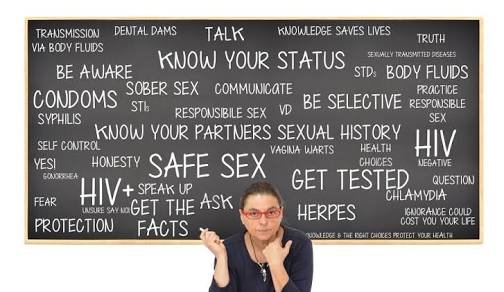Sex education
decisions about relationships, sexuality, and sexual behavior. The decisions they make can impact their health and well-being for the rest of their lives. Young people have the right to lead healthy lives, and society has the responsibility to prepare youth by providing them with comprehensive sexual health education that gives them the tools they need to make healthy decisions. But it is not enough for programs to include discussions of abstinence and contraception to help young people avoid unintended pregnancy or disease. Comprehensive sexual health education must do more. 
It must provide young people with honest, age-appropriate information and skills necessary to help them take personal responsibility for their health and overall well being.
This paper provides an overview of research on effective sex education, laws and policies that shape it, and how it can impact young people’s lives.
What is sexual health education?

Sex education is the provision of information about bodily development, sex, sexuality, and relationships, along with skills-building to help young people communicate about and make informed decisions regarding sex and their sexual health. Sex education should occur throughout a student’s grade levels, with information appropriate to students’ development and cultural background. It should include information about puberty and reproduction, abstinence, contraception and condoms, relationships, sexual violence prevention, body image, gender identity and sexual orientation. It should be taught by trained teachers. Sex education should be informed by evidence of what works best to prevent unintended pregnancy and sexually transmitted infections, but it should also respect young people’s right to complete and honest information. Sex education should treat sexual development as a normal, natural part of human development.
Why is sexual health education important to young people’s health and well-being?
Comprehensive sexual health education covers a range of topics throughout the student’s grade levels. Along with parental and community support, it can help young people:

Avoid negative health consequences. Each year in the United States, about 750,000 teens become pregnant, with up to 82 percent of those pregnancies being unintended. [1,2] Young people ages 15-24 account for 25 percent of all new HIV infections in the U.S. [3] and make up almost one-half of the over 19 million new STD infections Americans acquire each year.[4] Sex education teaches young people the skills they need to protect themselves.
Communicate about sexuality and sexual heath. Throughout their lives, people communicate with parents, friends and intimate partners about sexuality. Learning to freely discuss contraception and condoms, as well as activities they are not ready for, protects young people’s health throughout their lives.
Delay sex until they are ready. Comprehensive sexual health education teaches abstinence as the only 100 percent effective method of preventing HIV, STIs, and unintended pregnancy – and as a valid choice which everyone has the right to make. Dozens of sex education programs have been proven effective at helping young people delay sex or have sex less often.[5]
Understand healthy and unhealthy relationships. Maintaining a healthy relationship requires skills many young people are never taught – like positive communication, conflict management, and negotiating decisions around sexual activity. A lack of these skills can lead to unhealthy and even violent relationships among youth: one in 10 high school students has experienced physical violence from a dating partner in the past year [6]. Sex education should include understanding and identifying healthy and unhealthy relationship patterns; effective ways to communicate relationship needs and manage conflict; and strategies to avoid or end an unhealthy relationship. [7]
Understand, value, and feel autonomy over their bodies.
Abstinence-Only-Until-Marriage Programs, sometimes called Sexual Risk Avoidance Programs, teach abstinence as the only morally correct option of sexual expression for teenagers. They usually censor information about contraception and condoms for the prevention of sexually transmitted diseases (STDs) and unintended pregnancy.
Abstinence-Centered Education—Another term normally used to mean abstinence-only programs.
Comprehensive Sex Education teaches about abstinence as the best method for avoiding STDs and unintended pregnancy, but also teaches about condoms and contraception to reduce the risk of unintended pregnancy and of infection with STDs, including HIV. It also teaches interpersonal and communication skills and helps young people explore their own values, goals, and options.
Abstinence-Plus Education—Programs which include information about contraception and condoms in the context of strong abstinence messages.
COMPREHENSIVE SEX EDUCATION
ABSTINENCE-ONLY-UNTIL-MARRIAGE EDUCATION
Teaches that sexuality is a natural, normal, healthy part of life
Teaches that sexual expression outside of marriage will have harmful social, psychological, and physical consequences
Teaches that abstinence from sexual intercourse is the most effective method of preventing unintended pregnancy and sexually transmitted diseases, including HIV
Teaches that abstinence from sexual intercourse before marriage is the only acceptable behavior
Provides values-based education and offers students the opportunity to explore and define their individual values as well as the values of their families and communities
Teaches only one set of values as morally correct for all students
Includes a wide variety of sexuality related topics, such as human development, relationships, interpersonal skills, sexual expression, sexual health, and society and culture
Limits topics to abstinence-only-until-marriage and to the negative consequences of pre-marital sexual activity
Includes accurate, factual information on abortion, masturbation, and sexual orientation
Usually omits controversial topics such as abortion, masturbation,
and sexual orientation.
Provides positive messages about sexuality and sexual expression, including the benefits of abstinence
Often uses fear tactics to promote abstinence and to limit sexual expression
Teaches that proper use of latex condoms, along with water-based lubricants, can greatly reduce, but not eliminate, the risk of unintended pregnancy and of infection with sexually transmitted diseases (STDs) including HIV
Discusses condoms only in terms of failure rates; often exaggerates condom failure rates
Teaches that consistent use of modern methods of contraception can greatly reduce a couple's risk for unintended pregnancy.
Provides no information on forms of contraception other than failure rates of condoms
Includes accurate medical information about STDs, including HIV; teaches that individuals can avoid STDs
Often includes inaccurate medical information and exaggerated statistics regarding STDs, including HIV; suggests that STDs are an inevitable result of premarital sexual behavior
Teaches that religious values can play an important role in an individual's decisions about sexual expression; offers students the opportunity to explore their own and their family's religious values
Often promotes specific religious values
Teaches that a woman faced with an unintended pregnancy has options: carrying the pregnancy to term and raising the baby, or carrying the pregnancy to term and placing the baby for adoption, or ending the pregnancy with an abortion
Teaches that carrying the pregnancy to term and placing the baby for adoption is the only morally correct option for pregnant teens